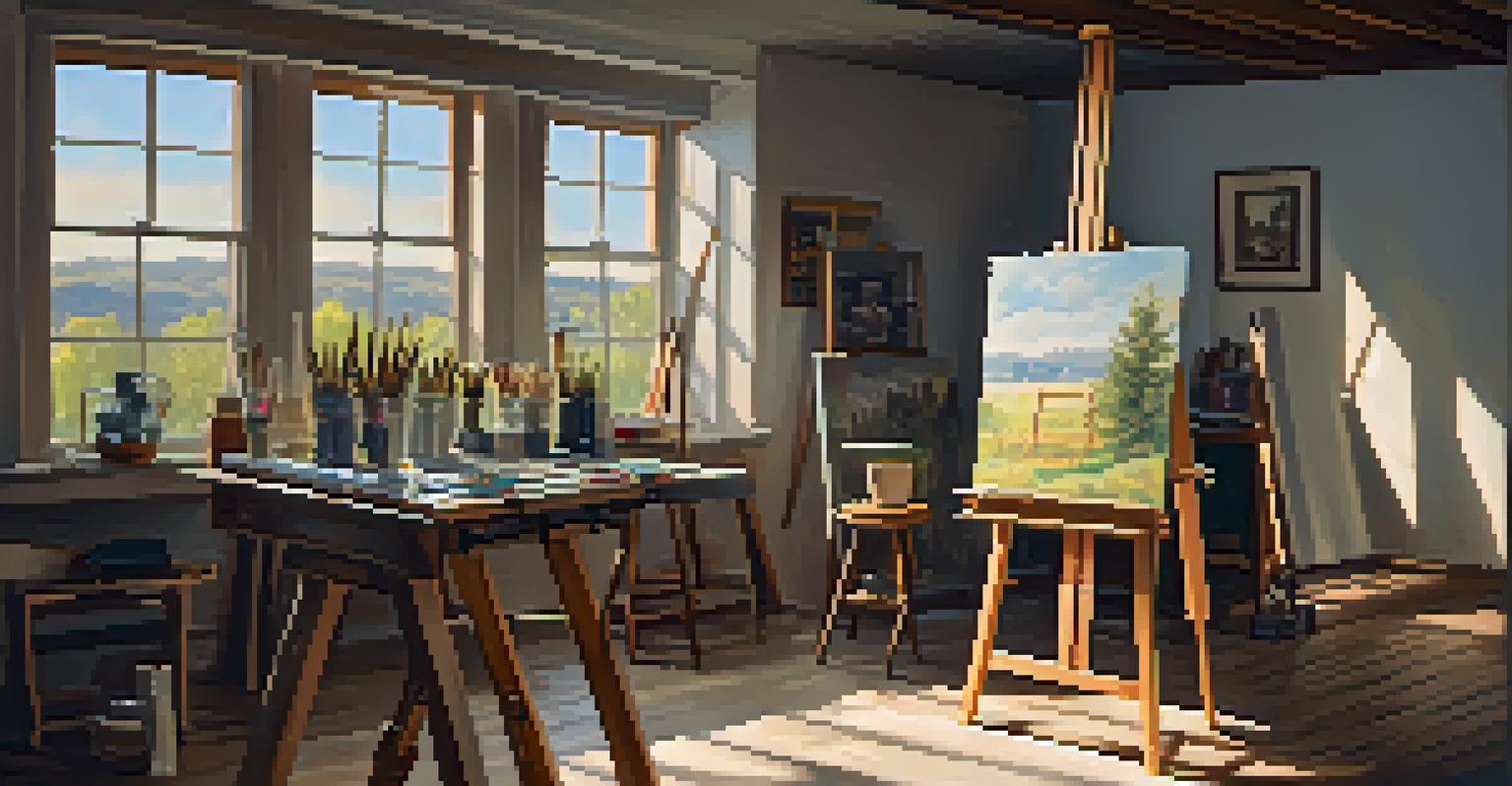The Function of Art in Remembering Significant Life Moments

Art as a Portal to Memories and Emotions
Art has a unique ability to evoke memories and emotions, acting like a time capsule. When we encounter a piece of art, it can transport us back to significant moments in our lives, reminding us of feelings we thought were long forgotten. For instance, a song might remind you of your first dance or a painting might take you back to a family vacation.
Art is the most beautiful of all lies.
These connections happen because art often encapsulates feelings and experiences that words cannot fully express. Just like a photograph, art can freeze a moment in time, allowing us to relive it whenever we see it again. This is why many people choose to create or collect art that resonates with their personal history.
In essence, art serves as a bridge between our past and present, making it an invaluable tool for remembering the moments that shape our lives. By engaging with art, we can explore our emotions and understand how they tie into our life experiences.
Creating Personal Narratives Through Artistic Expression
Art allows individuals to tell their stories in a deeply personal way. Whether it’s through painting, writing, or music, creating art can be a cathartic experience that helps people articulate their life journeys. For example, a diary filled with sketches can represent a person’s growth over the years, reflecting their highs and lows.

These artistic narratives not only help the creator process their experiences but also invite others to connect with them. When shared, these creations can resonate with others who may have undergone similar experiences, fostering a sense of community. Think of a powerful song that resonates with your own heartbreak; it can feel like the artist is speaking directly to you.
Art Evokes Memories and Emotions
Art acts as a time capsule, transporting us back to significant moments in our lives and evoking feelings we thought were long forgotten.
Ultimately, personal narratives expressed through art help to preserve significant memories. They become a part of our identity, allowing us to revisit and reflect on who we are and where we’ve been.
Art as a Catalyst for Celebration and Remembrance
Art plays a vital role in celebrations, marking significant life events such as weddings, graduations, and anniversaries. Customized artwork, like portraits or sculptures, can serve as tangible reminders of these joyous occasions. For instance, a wedding portrait can evoke the love and happiness of that day every time you look at it.
Every artist dips his brush in his own soul, and paints his own nature into his pictures.
Moreover, art can help us remember those we have lost. Memorial art, such as a dedicated painting or sculpture, offers a way to honor loved ones and keep their memory alive. This form of artistic expression becomes a celebration of life, allowing us to reflect on the joy they brought us.
By integrating art into our celebrations and remembrances, we create lasting legacies. These works become cherished heirlooms that tell our stories long after we’re gone.
The Therapeutic Power of Art in Memory Recall
Engaging with art can be a therapeutic practice, especially when it comes to recalling significant memories. Art therapy, for instance, has been shown to help individuals process trauma and unlock buried emotions. By creating or interacting with art, people can explore their feelings in a safe and constructive space.
This therapeutic approach can be particularly beneficial for those struggling with memory loss or grief. Through creative expression, they can access memories and emotions that might otherwise remain hidden. Think of it as a gentle nudge, guiding them to rediscover moments that matter.
Art as a Personal Narrative Tool
Creating art allows individuals to express their personal stories, fostering connections with others who share similar experiences.
Thus, the therapeutic power of art not only aids in memory recall but also promotes healing. It allows us to confront and process our past, paving the way for acceptance and growth.
Art and Collective Memory in Communities
Art also plays a crucial role in shaping collective memory within communities. Public art, such as murals, monuments, and installations, can commemorate significant events and figures in a community’s history. For example, a mural depicting local heroes can remind residents of their shared heritage and inspire pride.
These artistic expressions foster a sense of belonging, helping individuals connect with their community's past. They serve as visual reminders of struggles, triumphs, and milestones that have defined the community over time. This is particularly evident in cities that celebrate their history through art festivals and exhibitions.
In this way, art becomes a communal experience, enriching the collective memory and ensuring that important moments are not forgotten. It invites dialogue and reflection on shared values, reinforcing the bonds that hold communities together.
The Role of Art in Personal Rituals and Traditions
Art often intertwines with personal rituals and traditions, enriching the significance of these moments. Whether it’s creating handmade decorations for a holiday or crafting a unique gift for a loved one, art brings a personal touch to our celebrations. For example, a family tradition of painting ornaments during the holidays can create lasting memories for generations.
These artistic rituals not only enhance the experience but also foster connections among family and friends. They provide opportunities for shared creativity and expression, reinforcing bonds and creating a sense of unity. Think about how a collaborative art project can become a cherished memory for everyone involved.
Art Preserves Collective Memory
Public art helps shape collective memory within communities, commemorating significant events and figures that inspire pride and belonging.
Ultimately, the role of art in personal rituals underscores its importance in marking significant moments in our lives. It transforms ordinary occasions into extraordinary memories, celebrated through creativity.
The Timeless Nature of Art in Preserving Memories
One of the most beautiful aspects of art is its timelessness. Unlike many aspects of life that fade with time, art has the power to preserve memories for future generations. A well-crafted piece can resonate with audiences long after it was created, allowing memories to be shared across time.
Consider classic literature or iconic paintings that continue to evoke emotions and tell stories today. These works serve as bridges to the past, helping us understand different perspectives and experiences. They remind us that while life changes, the essence of our memories can endure through art.

In this way, art becomes a legacy, a way to immortalize our significant life moments. It invites future generations to reflect on our experiences, ensuring that our stories are passed down and remembered.